A work calendar is an essential tool for keeping track of your projects and working with external stakeholders. It helps you manage meetings, deadlines, and important events in one location. But with so many calendar platforms available, it can be overwhelming to find the right one.
Don’t worry — we’re here to help!
In this article, we’ll share our top picks for the best calendars for work in 2025. From customizable features to integration capabilities, these calendars are designed to help you stay on top of your schedule and increase productivity.
We’ll also unpack the important features of our top 15 work calendar apps for 2025:
- Motion
- TeamUp
- iCloud Calendar (aka Apple Calendar)
- RotaCloud
- Jolt
- Google Calendar
- Microsoft Outlook
- Digical
- Zoom Workplace
- Fantastical
- Calendar
- Timepage
- Chili Piper
- Sessions
- Vantage
But first, let’s clarify what a work calendar is and why it’s important to use one.
Intelligently plan your day with Motion
Sign up now to get started
What is a work calendar?
A work calendar is a tool for managing your work schedule. It typically includes tasks, work-related events, appointments, meetings, deadlines, and other important dates. Your entire calendar may also include meeting locations, attendees, email reminders, and other information.
When used well, a work calendar helps individuals and teams track their schedules and prioritize their tasks. It improves organization, increases efficiency, and reduces the risk of missed deadlines.
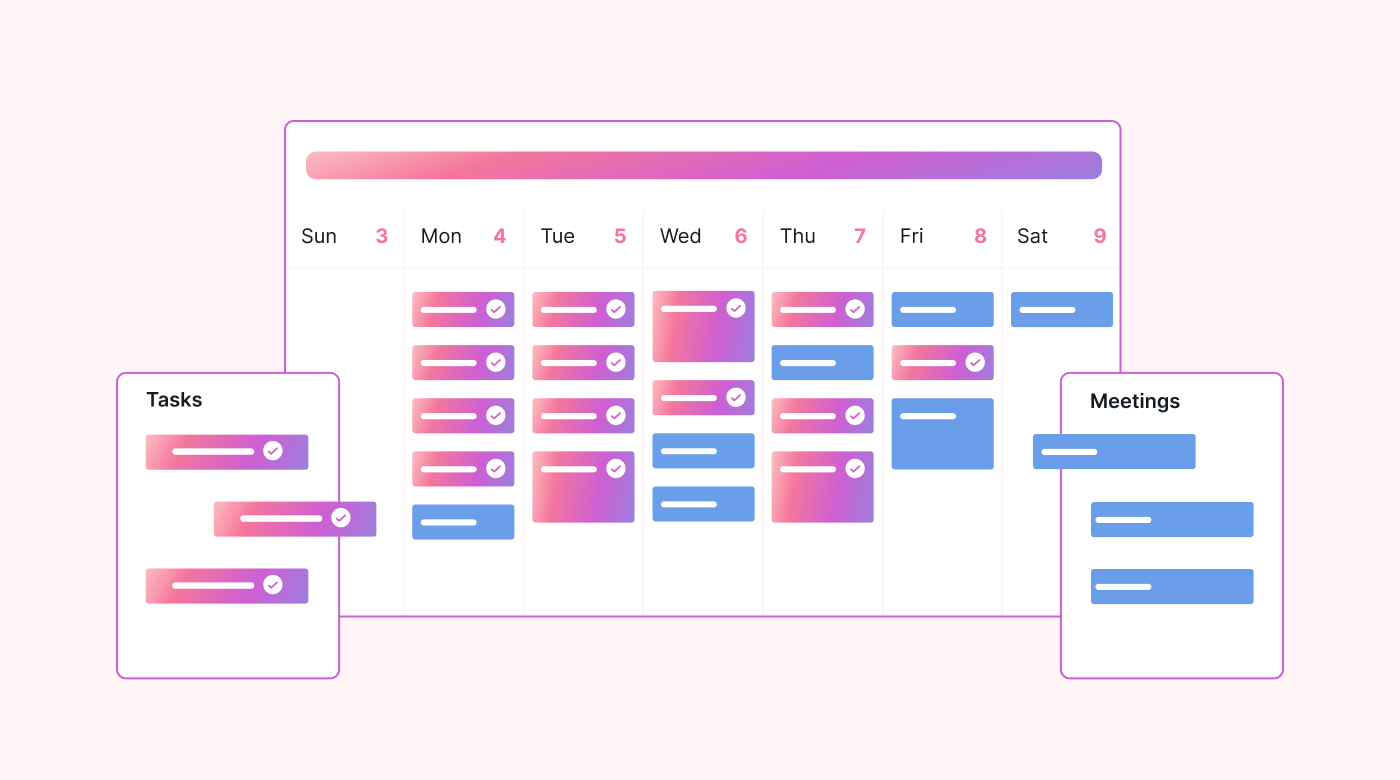
There are two standard formats for a work calendar. The first is a physical format (such as a paper planner or a whiteboard), and the second is a digital calendar (such as an online calendar or all-in-one digital planner).
Out of the two methods, a digital work calendar is more efficient — especially if it’s cloud-based. It’s quicker to update, easier to change, and helpful for teams that want to share updates about their schedules. It also provides a common space for scheduling and sharing information, which helps teams to communicate about work tasks and schedules.
What is the importance of a work calendar?
Some of the benefits of using a work calendar to manage your schedule include the following:
- Improve time management. Work calendars are a great way to improve your time management. They help you schedule tasks, meetings, and deadlines, which enables you to split your time between tasks and complete your work on time.
- Increase productivity. A work calendar provides a structured schedule. You know exactly what you need to do and when you need to do it, which helps you stay focused and productive.
Find out more about boosting productivity in this article: How Motion Users Finish Work 2 Hours Faster Every Day (2022 Productivity Statistics)
- Better organize work. A work calendar is a great way to organize your work — especially if you have a hectic schedule. You can plan every task in your workload, helping you get a handle on your schedule and deliver tasks on time.
- Reduce stress. Mental clutter can cause stress. There are studies out there that prove it. With a work calendar, you can organize your busy schedule and structure your daily work. As a result, you’ll be less stressed and more likely to complete work on time and to a higher standard.
The 15 best calendars for work in 2025
Our list of the most effective work calendars is based on our review of the following features and functionalities:
- Usability. Is the calendar easy to use? Does it require training, or can you start using it instantly?
- Integrations. Does the calendar integrate with third-party tools? If so, how many and which tools?
- Flexibility. Is the calendar customizable? Can you design a calendar that’s perfect for your schedule?
- Automation. Can you automate tasks from your calendar? Does it automatically reshuffle tasks if you have to rearrange your schedule?
Using these areas as our guide, we’ve narrowed our choices down to 15 of the best online work calendars for 2025. Let’s take a dive into the details of each one of them.
1. Motion: The best online work calendar for automatically updating your schedule
Motion is an online, AI-powered task management and calendar platform. It helps busy people and teams manage their work with an efficient, simple, and intuitive calendar and task manager.
The AI-driven software helps you plan your schedule based on different variables involved, such as deadlines, work hours, priorities, and length of tasks. You’ll tell it the relevant information and the intelligent calendar will automatically find time on everyone’s calendars for meetings and schedule tasks for you in the optimal timeslots to meet priorities, dependencies and deadlines.
If your plans change or a new high-priority task comes up, the Motion app will reschedule or reshuffle tasks based on those rules. Once meetings or events are scheduled, it won’t move them automatically.
So Motion serves up your schedules for you. This feature means you spend less time manually choosing what to do next, and more time doing your work.
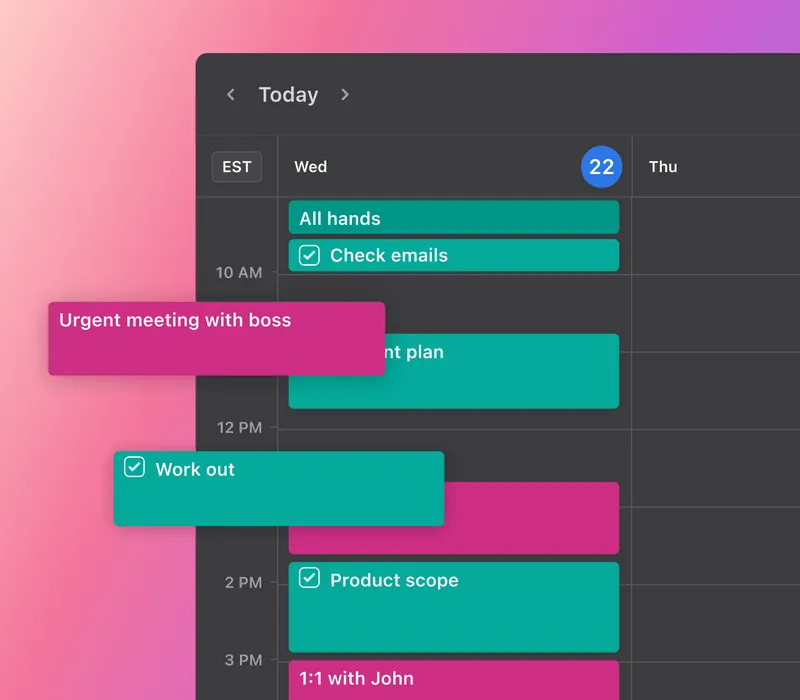
You can also integrate other types of calendars with your Motion calendar. You can combine your Google and Outlook calendars into one view, allowing you to visualize your entire schedule on a single screen.
Motion offers integration with multiple calendars, Zoom, and Microsoft Teams, and hundreds of other apps using Zapier. When using Siri with Motion, you can create tasks with your voice.
Motion is also a helpful planning tool for businesses of different sizes. From startups to executive teams, the platform can support businesses of all shapes and sizes. And this is also true across a wide range of industries (including IT service providers, marketing agencies, and more).
Motion Pros: An intuitive, simple-to-use AI-driven scheduling and productivity tool that automatically plans your days and replans according to changes.
Motion Cons: Limited set of project views.
Motion Pricing: Starts at $19 per month when billed annually.
2. TeamUp: The best for making simple, collaborative calendars
TeamUp is an online calendar that helps teams organize, plan, and share their work schedules. It has a simple interface that’s easy to use, customizable, and visually appealing.
For global or distributed teams, TeamUp can be a useful tool for communication and collaboration. For example, users can add comments to tasks to share updates, ask questions, or generally keep in touch.
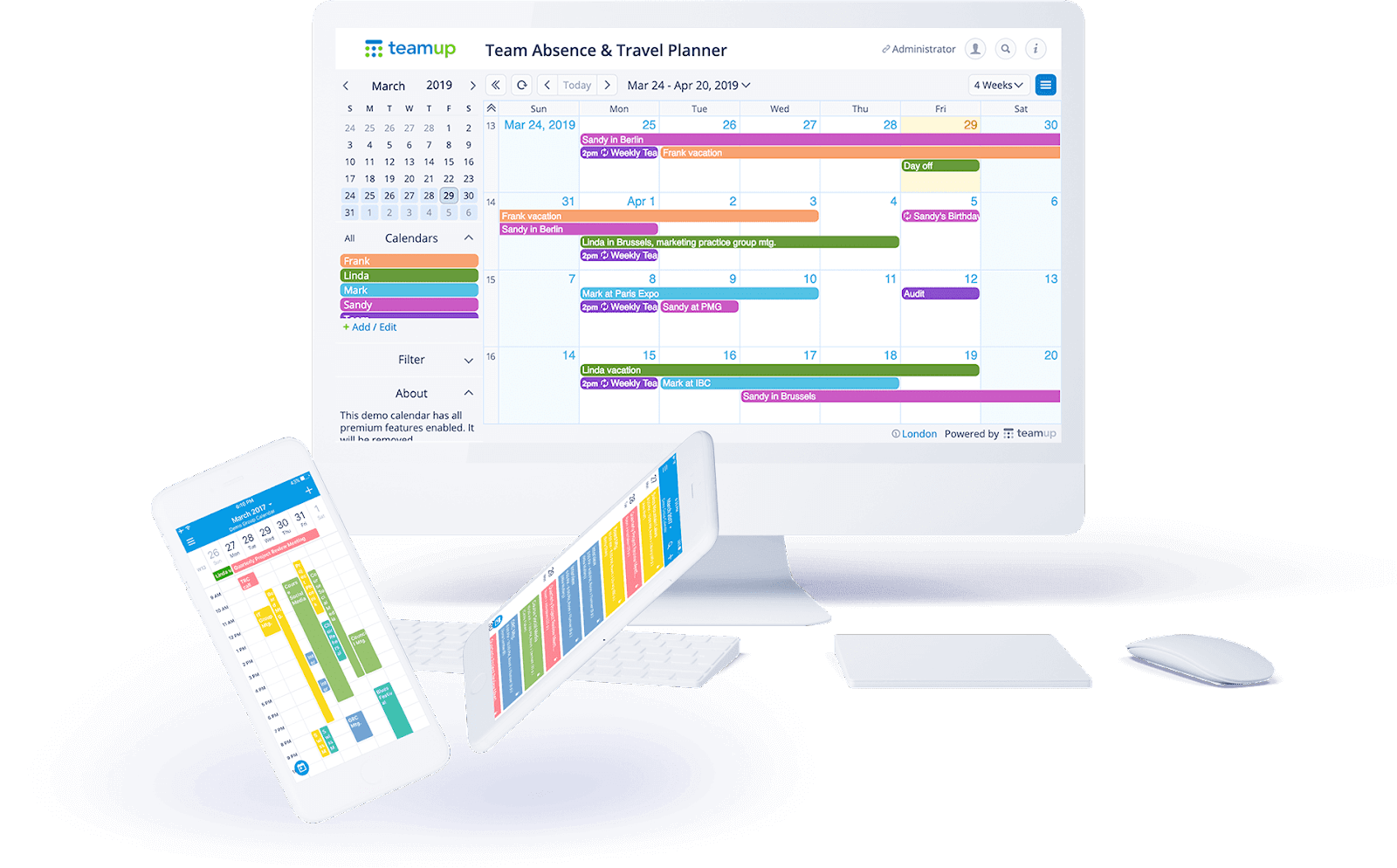
Despite its handy collaborative features, some customer reviews say the color options are too similar. With a busy schedule, this can make it hard to distinguish between the types of tasks.
TeamUp Pros: Easy to use and collaborative.
TeamUp Cons: Lack of color options for categorizing tasks.
TeamUp Pricing: Free for up to 8 sub-calendars.
3. iCloud Calendar: The best free calendar for the Apple tech stack
Also known as Apple Calendar, this work calendar is one of three that come preinstalled on specific devices. If you’ve already invested in a MacBook, iPhone, or iPad, it’s free for you to use and accessible immediately.
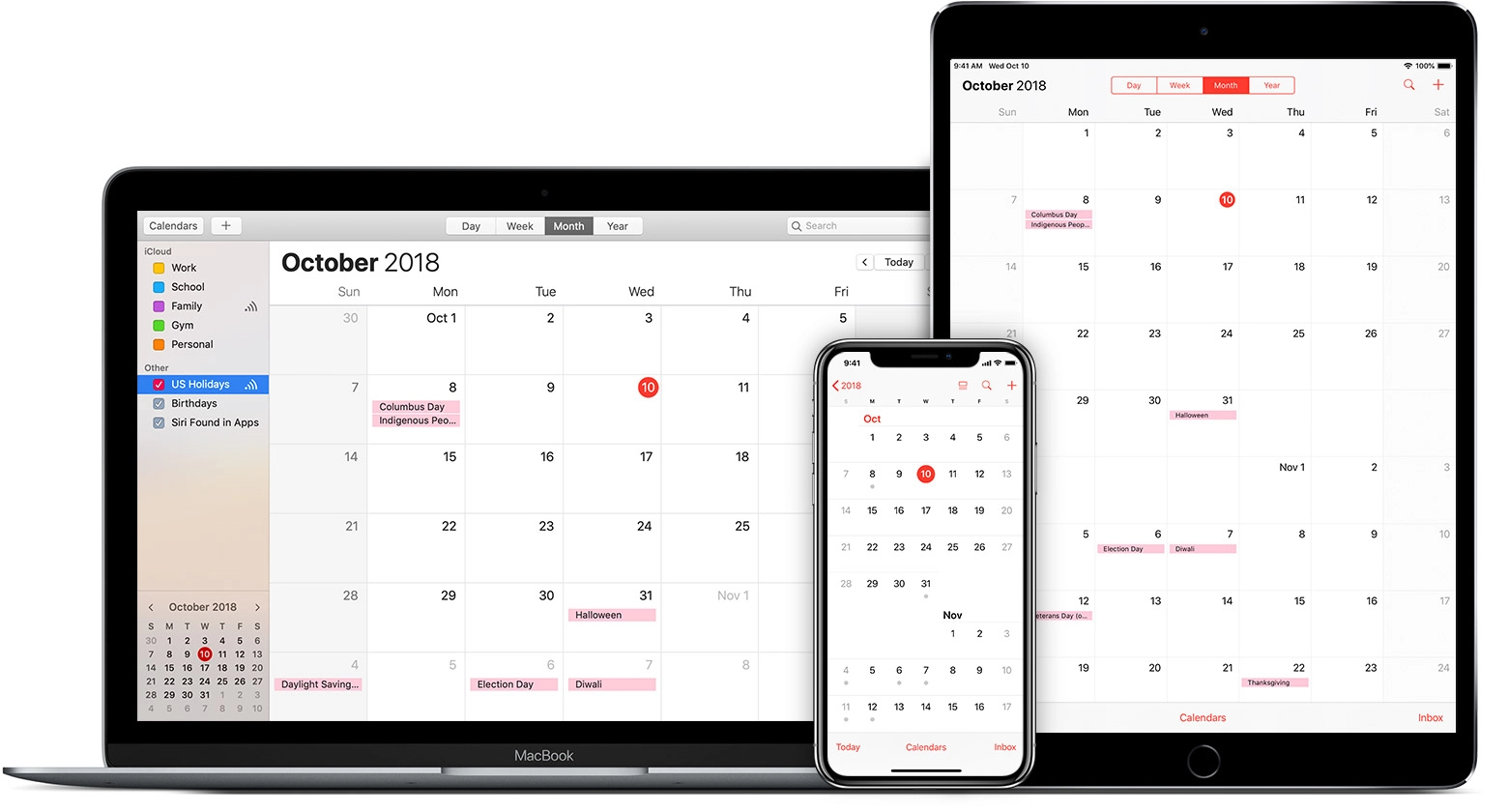
Like many Apple products it’s most remarkable features are a clean look and feel, and simplicity of use. If everyone you work and collaborate with is also in the Apple universe, then it may work quite well for you. But it lacks customization functionality and if you need to work with Windows or Linux devices, the warts begin to show.
iCloud Calendar Pros: Integrates very well with all Apple devices.
iCloud Calendar Cons: Almost no deep customization features.
iCloud Calendar Pricing: Free if you’re already an Apple fan.
4. RotaCloud: The best for planning shifts and rotas
RotaCloud is a cloud-based platform that helps businesses create and manage employee schedules. Some of its features include shift planning, time and attendance tracking, and absence management.
The platform also integrates with external software, such as Sage for payroll, Breath for HR, and Zapier for automation.
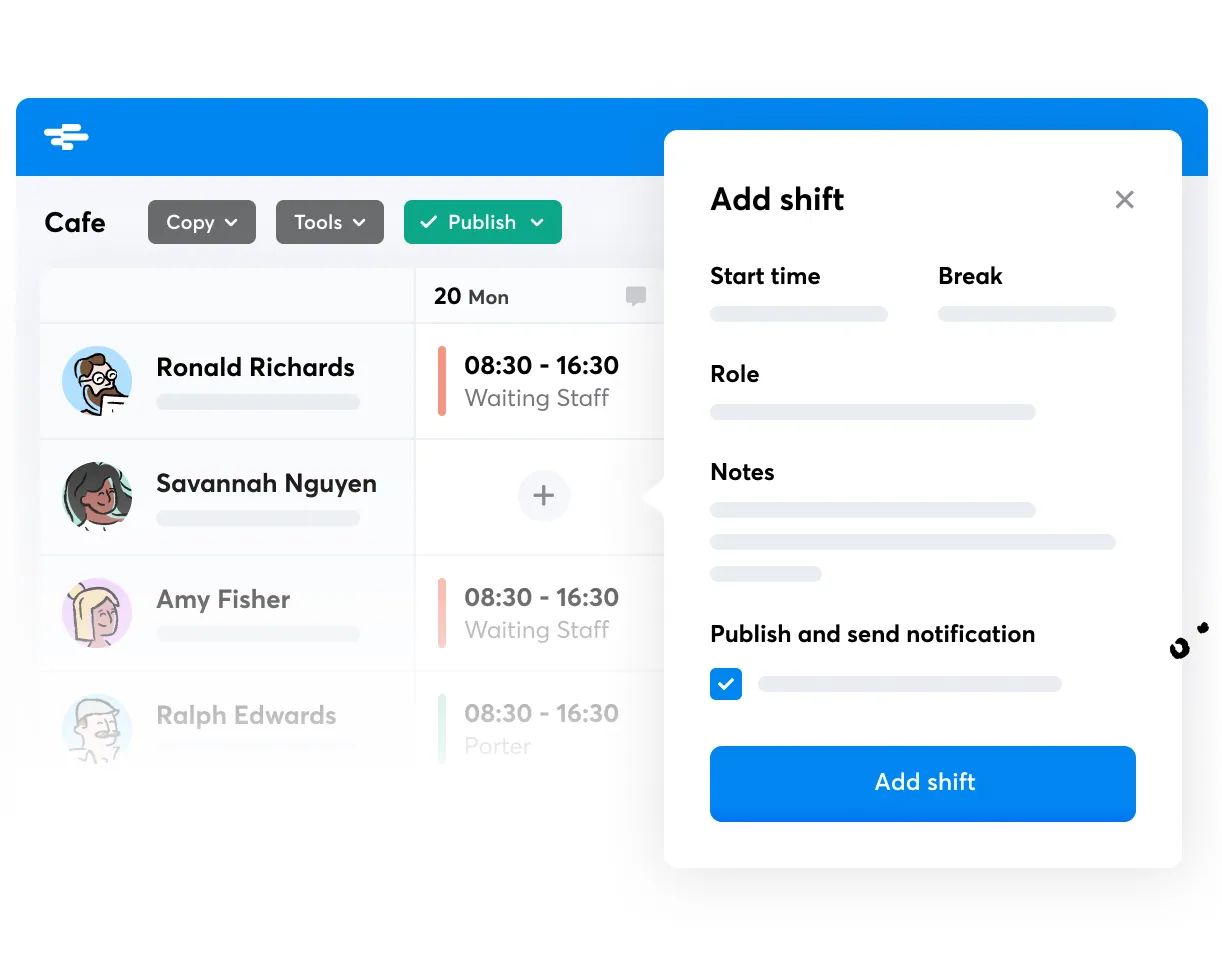
Employers can use RotaCloud to create schedules that incorporate employee availability, shift patterns, and labor laws. Employees can also use the platform to view their schedules, ask for time off, and swap shifts with colleagues.
However, the platform does have some limitations when it comes to granular details. For example, you’re unable to view the daily-hour total on a weekly rota. In the grand scheme of the platform, these details are small, and it’s still an efficient tool for managing shifts.
RotaCloud Pros: Easily schedule and manage employee shifts.
RotaCloud Cons: Limited amount of granular details.
RotaCloud Pricing: Starts at $10 per month for one employee.
5. Jolt: The best for managing employee schedules
Jolt helps businesses in the hospitality and retail industries to manage their operations. It’s a cloud-based system that allows employers to manage employee scheduling, track time and attendance, and manage tasks.
Jolt also offers inventory management tools to help businesses track their stock levels. It reduces waste and gives you a clear picture of your stock and resources.
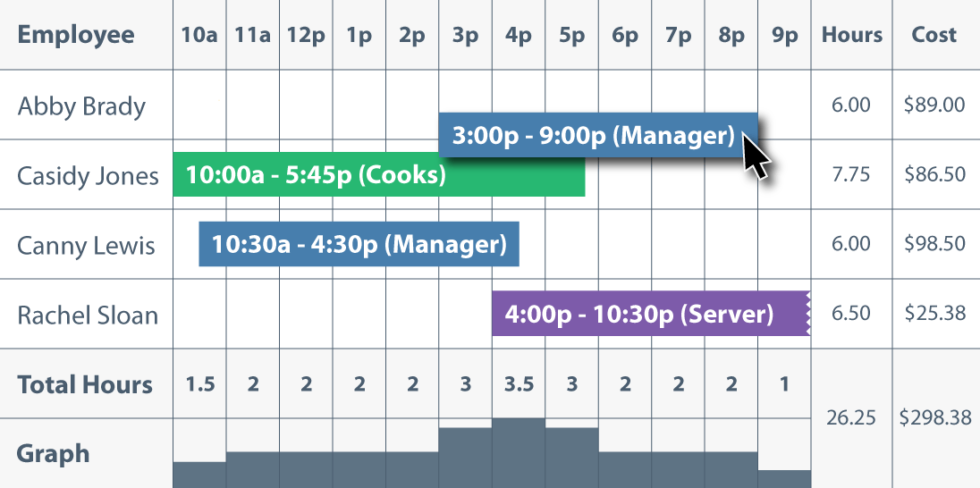
Although the platform is great for managing employee schedules, the interface can take a while to get used to. It’s easy to use once you’ve wrapped your head around it, but it takes a bit of time to figure out exactly how it works.
Jolt Pros: Manage employee schedules and track inventory on the same platform.
Jolt Cons: The interface could be slightly easier to use.
Jolt Pricing: Contact Jolt directly for a quote.
6. Google Calendar: The best for time blocking
Google Calendar is a free online calendar that helps businesses and individuals plan their events, appointments, and tasks. It’s preinstalled on every Chromebook but anyone with any device can use it with a Gmail account. It’s simple to use and has various features that make it helpful for work management.
For example, you can add recurring tasks, allow notifications, and integrate with other Google services (such as Gmail and Google Meet). Users can also create multiple calendars, share them with others, and sync calendars across multiple devices.
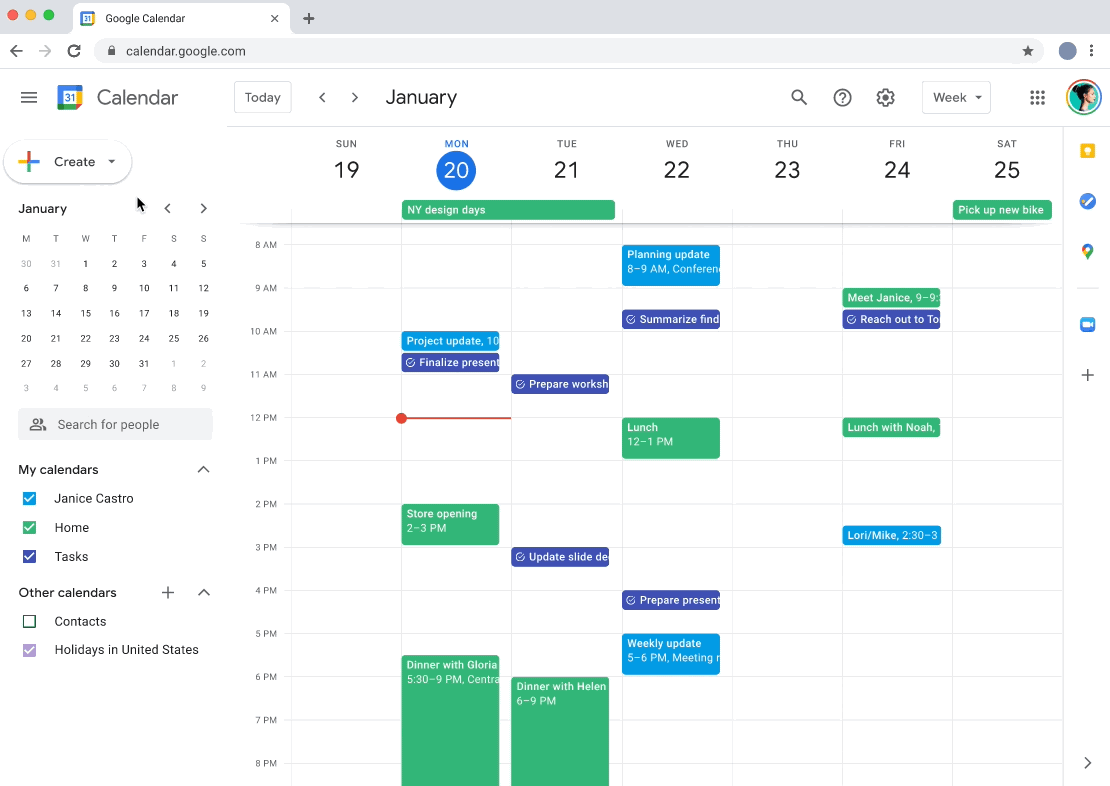
Google Calendar users will typically use time blocking to plan their schedules. Time blocking involves scheduling your day into blocks. It helps you visualize when to do your tasks and how long they should take — but using this method with Google Calendar does have its challenges.
For example, you have to manually prioritize tasks yourself, which can be time-consuming if you have a busy schedule with conflicting deadlines. Plus, if your schedule changes, you have to reorganize everything yourself.
In other words, it’s not as efficient as using a calendar that automatically reshuffles your schedule (like Motion).
Google Calendar Pros: It’s simple and free to use.
Google Calendar Cons: It doesn’t automatically update when you make changes.
Google Calendar Pricing: Free to use for Chromebook owners, gmail users and Google Workspace subscribers. Google Workspace pricing begins at $6 per user per month and gives you access to considerably more than just a calendar app.
7. Outlook Calendar: The best for the Microsoft tech stack
What iCloud Calendar is to Apple, Outlook is to Microsoft: tightly integrated into its ecosystem and not straying too far beyond that. Like Google, if you have a Microsoft account, you can access a free version or upgrade to an Office 365 premium plan.
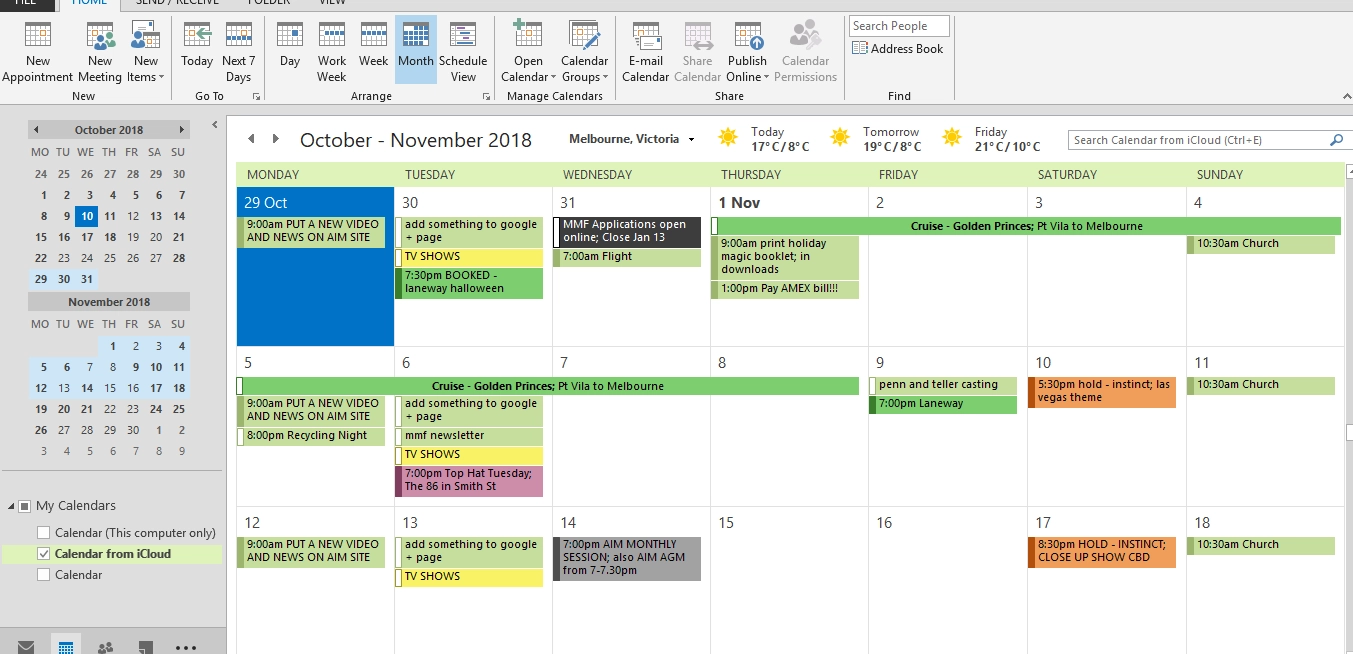
Microsoft Outlook lets you create multiple calendars and sync with others — just as long as they are also part of the Microsoft universe. It lets you manage team calendars, create events and add guests via email. However, you do lose some features if your email account doesn’t use an Exchange Server.
Outlook Calendar Pros: Very tight integration with Outlook and Windows.
Outlook Calendar Cons: Some features are locked into the Microsoft ecosystem
Outlook Calendar Pricing: Free if you’re a paying Microsoft customer.
8. Digical: The best for creating stylish and eye-popping calendars
Digical is an Android calendar app that syncs with Google Calendar, Outlook, and Exchange. It uses widgets to create stylish calendars across multiple devices. The customizable calendar widgets breathe some personality into your work schedule, making it fun and easy to plan your work activities.
You can also choose from a variety of calendar views to select a format that works best for you and your team.
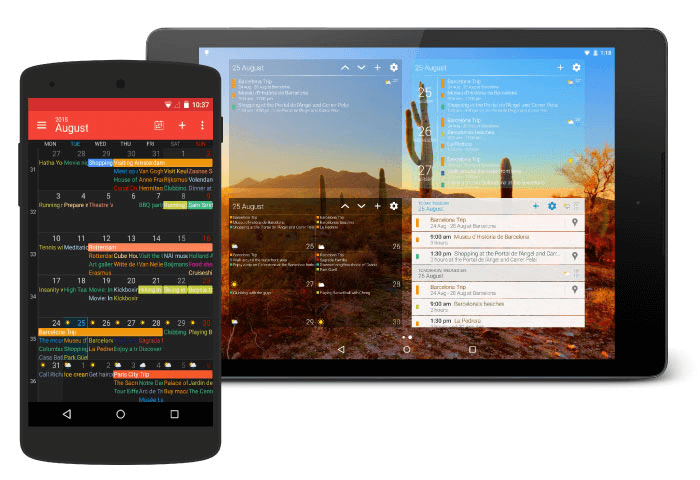
Although the widgets will make your calendar look pleasant, they can make it hard to visualize all your tasks. Because of the structure, your calendar can quickly appear overcrowded, making it harder to track and manage.
DigiCal Pros: It creates eye-popping calendars that are fun to make.
DigiCal Cons: It can get overcrowded, making it harder to manage your work.
DigiCal Cost: Free to use (in-app purchases available to upgrade and remove ads).
9. Zoom Workplace: The best for the hybrid workplace
Before COVID, Zoom was just another nice to have technology of no real practical value. That changed with the pandemic as it became the de facto video conferencing option for academic interactions and to stay connected in personal life. To get the attention of the elusive business market, the company launched Zoom Workplace earlier this year.
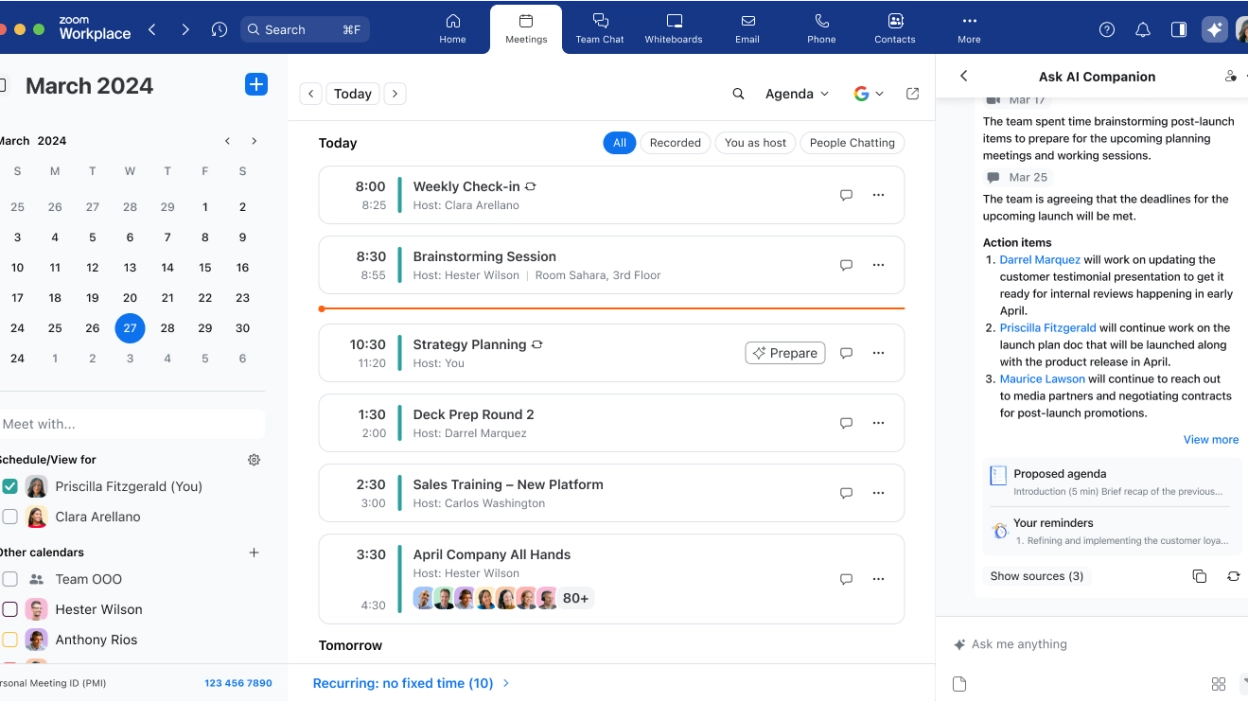
It’s effectively a calendar that brings together meetings, team chats, phone calls, and email, and then adds AI into the mix. It’s a collaboration platform that lets you quickly elevate a chat to a meeting or phone call, and use digital collaboration tools like whiteboards, clips, notes, surveys, and documents.
Zoom Workplace Pros: Easy to use with integrated video conferencing.
Zoom Workplace Cons: Limited free plan.
Zoom Workplace Pricing: $14.99 per user per month.
10. Fantastical: The best for the Apple tech stack
If you’re an Apple convert but you need to interact with others who’ve made different technology choices, Fantastical is a paid online calendar app to consider. It was developed for the Apple ecosystem but it can sync calendars seamlessly with the wider world including Google Calendar, Outlook Calendar, and others.
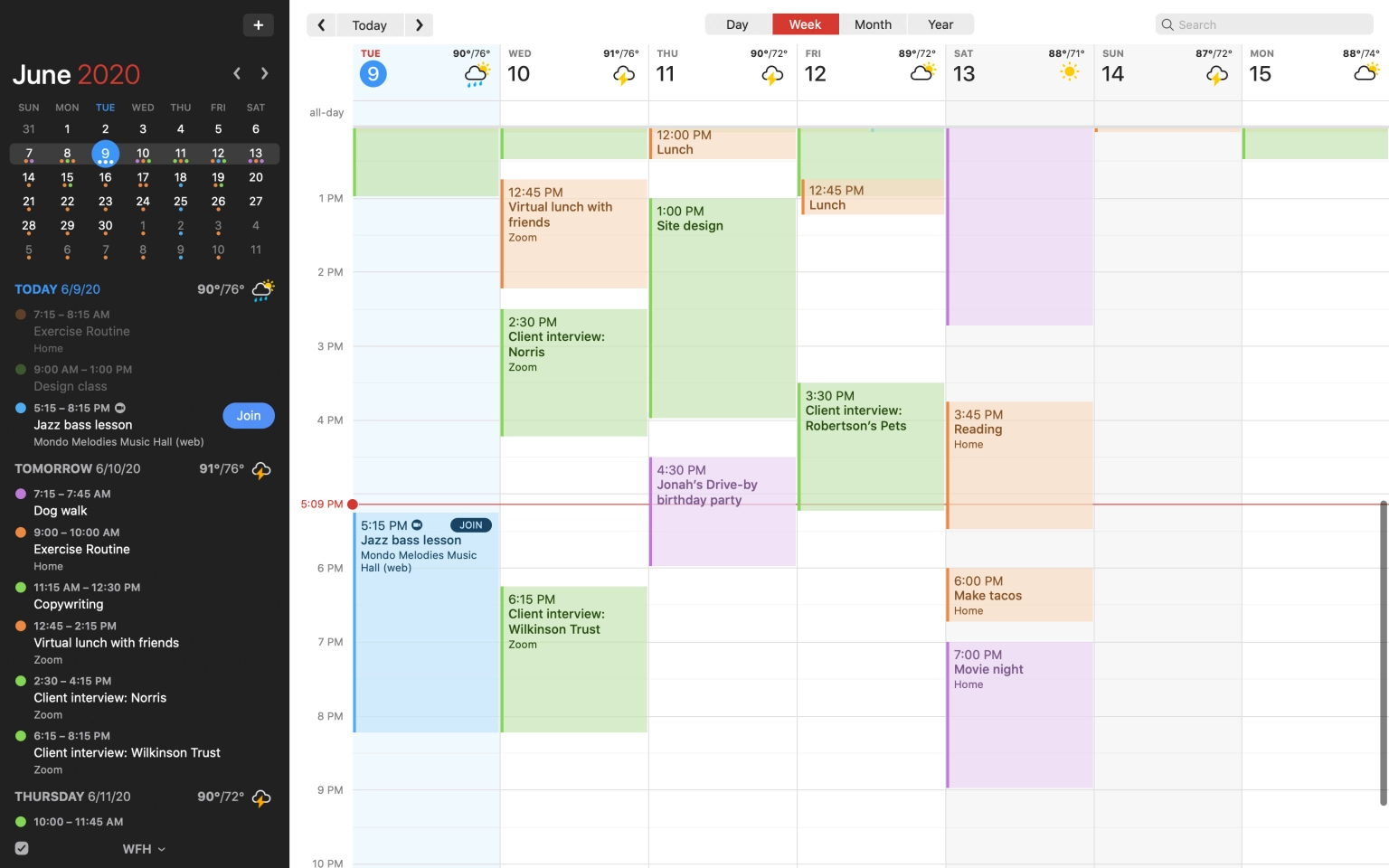
A standout feature is the ability to propose multiple meeting times or dates to guests, which is finalized once guests select the slots when they are available. Fantastical also supports six different languages (English, French, German, Italian, Spanish, and Japanese).
Fantastical Pros: Geo-fencing gives you a reminder when you arrive at a location connected to an event you created.
Fantastical Cons: Subscription required for many features that are free in other apps.
Fantastical Pricing: $4.99 per user per month. A family plan is available for $7.99 per month and both are discounted if you pay annually.
11. Calendar: The best for external scheduling
If you're looking for a mobile or cloud-based solution, you could take a chance on Calendar. For a start, it syncs with Apple Calendar, Google Calendar and Outlook Calendar, and it also integrates well with Zoom and Zapier to help you maximize productivity.
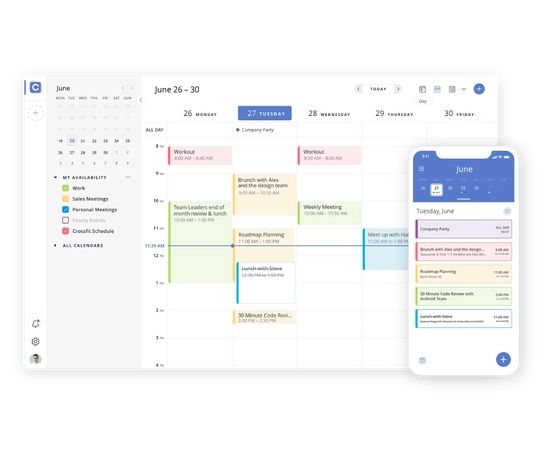
It features a scheduling page that lets you create specific time slots for your different meetings. You can also create workspaces for different teams or businesses you’re involved in. And it offers analytics, which lets you see a graphical representation of how many meetings you’ve attended, how long they took, and your missed or rejected events.
Calendar Pros: Multiplatform support and many features.
Calendar Cons: Limited free version.
Calendar Pricing: Starts at $10 per user per month.
12. Timepage: The best for accessing unique calendar features
Timepage is an iOS calendar app with a sleek and simple interface for managing your work schedule. It was created by Moleskine, the Italian brand known for producing high-quality notebooks and stationery products.
The app has a few features that make it unique. For example, it has a horizontal timeline that allows you to view your calendar app tasks in a linear format. It also has a heat map that shows you which days are your busiest, which is a valuable feature for checking your calendar for availability.
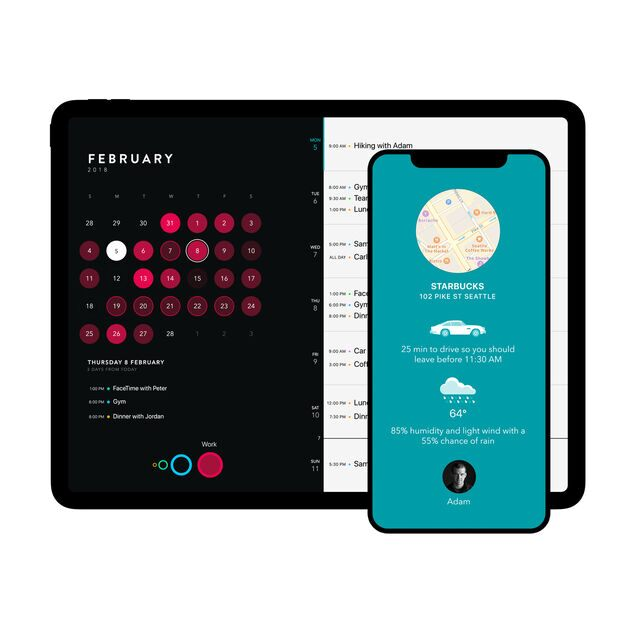
The main downside to consider is that if you want to use Timepage, you have to subscribe to the entire Moleskine Studio (which includes Actions and Flow).
Timepage Pros: Highly customizable.
Timepage Cons: To use Timepage, you have to pay for Moleskine Studio.
Timepage Pricing: $2.49 per month or $14.99 for annual membership.
13. Chili Piper: The best for sales teams
One of the few apps focused almost entirely on the sales funnel, Chili Piper is best described as scheduling and routing software for B2B revenue teams. It integrates with your CRM to qualify and route leads using segmentation data.
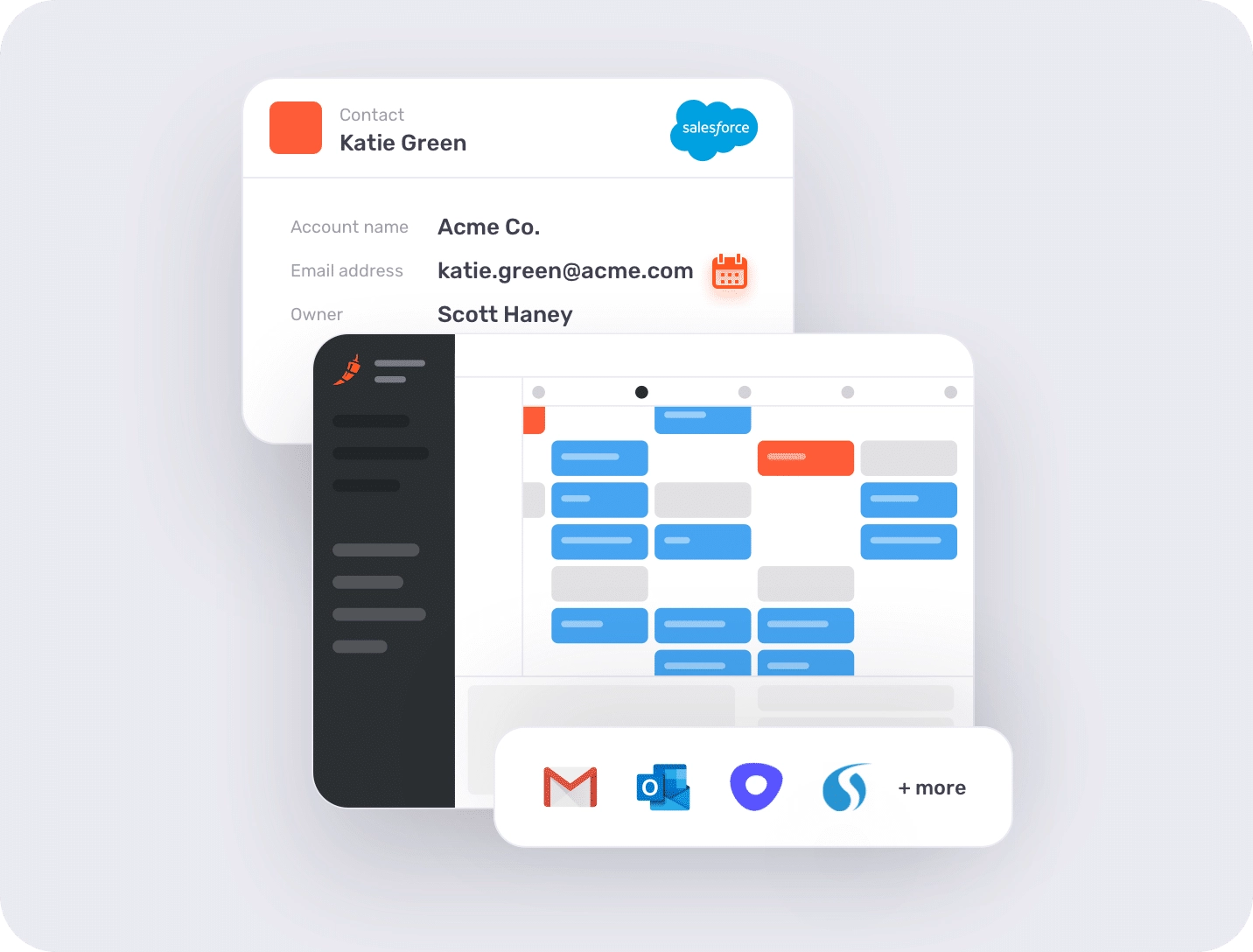
Chili Piper pulls lead data from any inbound web form and routes those leads to the appropriate sales rep, giving them an option to book time on their calendar immediately. It helps sales teams improve inbound conversion rates, increase customer satisfaction, and enhance productivity.
Chili Piper Pros: Support for multiple (26) languages, including Chinese.
Chili Piper Cons: Can be expensive.
Chili Piper Pricing: The platform fee is calculated based on the number of inbound leads submitted monthly. Up to 100 is $150. Up to 1000 is $400. More than 1000 is $1000.
14. Sessions: The best for remote teams
Like Zoom Workplace, Sessions provides a calendar front end to a video conferencing platform that https://zapier.com/apps/motion/integrations for webinars, workshops, training, and demonstrations. It allows you to share your calendar and lets invitees select a time that suits everyone.
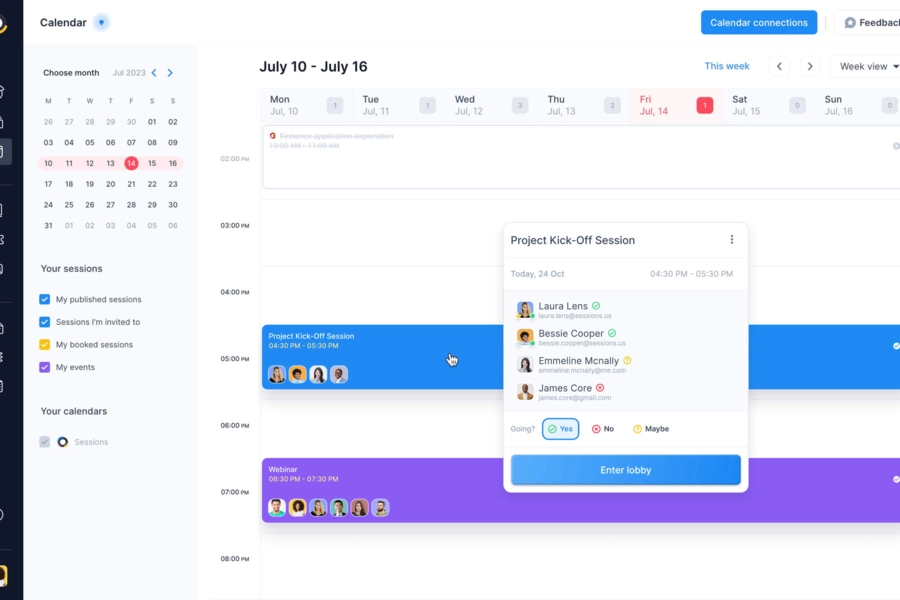
The AI Copilot enhances the meeting experience, and the platform offers one workspace for your team, including cloud storage of all sessions. The product also features interactive agendas, and the free plan gives you a taste of everything except the AI Copilot.
Sessions Pros: Interactive agendas to which all invitees can contribute.
Sessions Cons: The automatic recording and transcription can throw up inconsistencies.
Sessions Pricing: From $19 per month.
15. Vantage: The best for creating an interactive calendar
Vantage is an online calendar app that helps teams and individuals to plan and schedule their work. It uses visual cues (like colors, stickers, book covers, and stacks) to create an engaging scheduling experience.
Of all the features Vantage has, the scroll view is the most unique. It allows users to flick through their calendar by scrolling up or down on their screen.

Despite its unique calendar views, Vantage still has room for improvement. Some customer reviews suggest that there are have been some technical glitches that prevent a totally seamless experience.
Vantage Pros: Unique calendar views.
Vantage Cons: Some users have experienced technical issues.
Vantage Price: $9.99 one-off purchase.
Key features to look out for in a work calendar tool
As mentioned, it helps to know what features to look for when searching for the right work calendar for your business. We’ve outlined some of the most helpful calendar features to get you started on the right foot.
- Automation. Nobody can do your work for you. But automation can help you plan your schedule of events and tasks more intelligently. It can recognize your priorities, the dependencies, and the deadlines. And it can help you rearrange your schedules when priorities change.
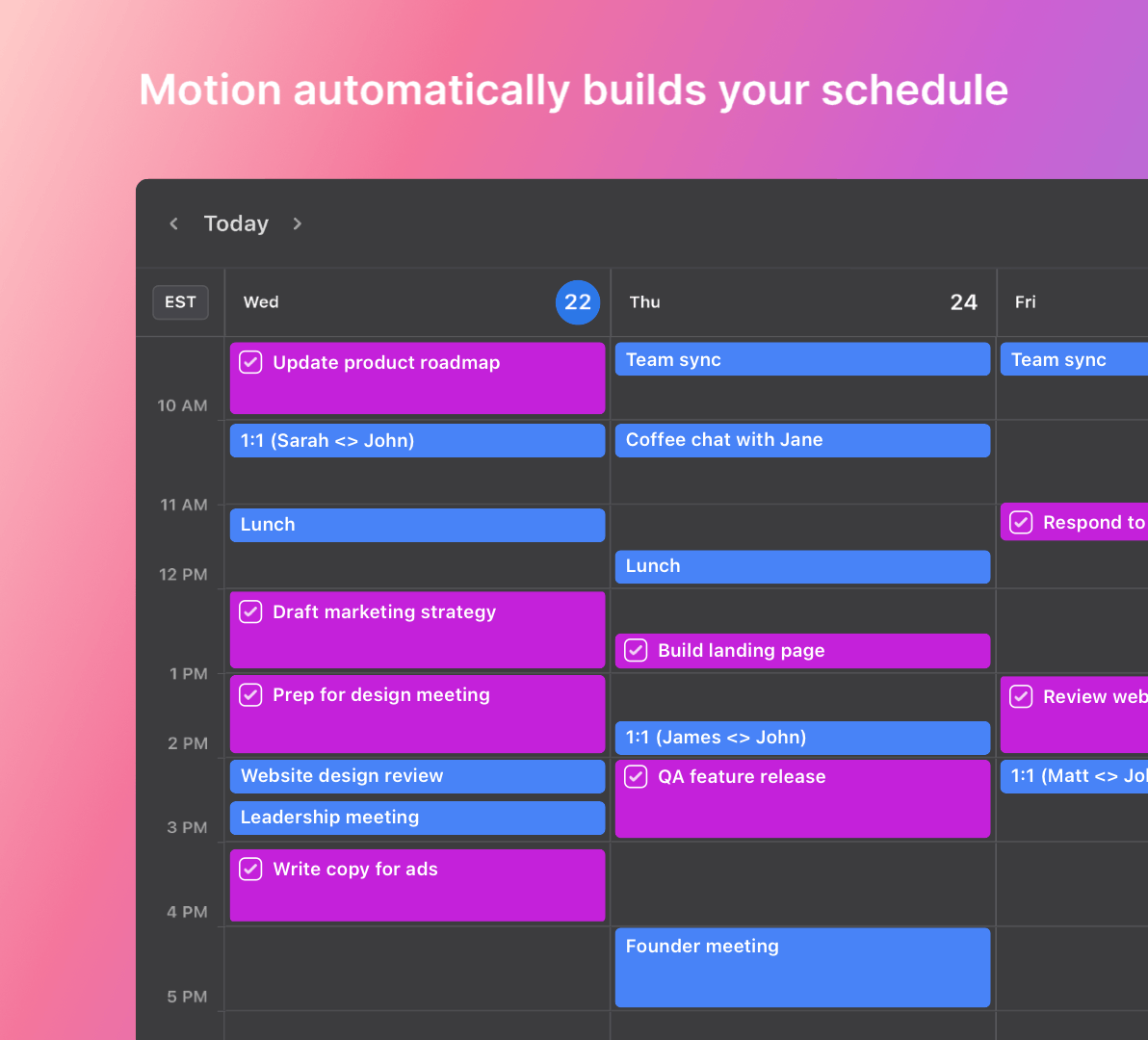
- Ease-of-use. The calendar should have a user-friendly interface, making it easy to navigate, add and edit events, and view your schedule. Take a look at Motion’s calendar as an example. You can easily drag and drop tasks, automatically update your schedule without manually moving things around, and even categorize and label tasks to help with prioritization.
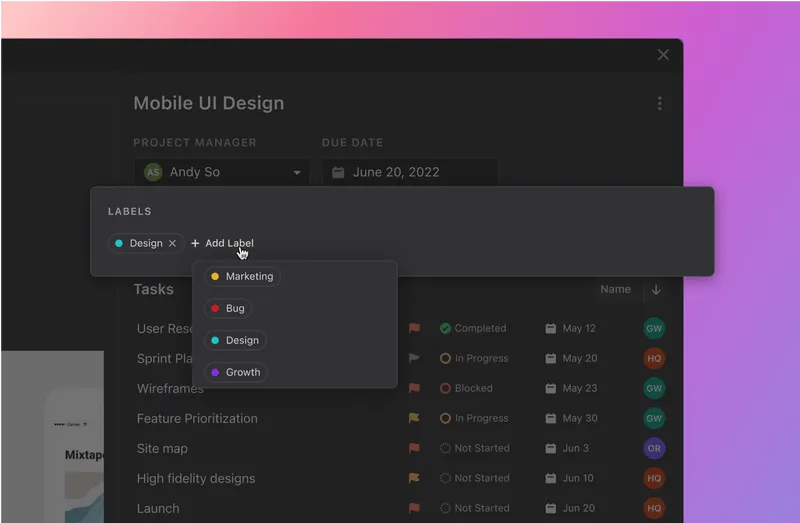
- Merging calendars. Ideally, your work calendar should sync with other calendars, including the shared team calendar and the individual calendars of team members. This means that everyone can instantly access information about team schedules. For example, if an employee wants to book a meeting with you, they can review your calendar to see when you’re available.
- Collaborative. A work calendar should be collaborative and allow team members to work together. With Motion, for example, users can add comments to tasks in their calendars. This feature enables team members to communicate and makes it easier for remote and hybrid users to keep in touch and discuss work tasks.
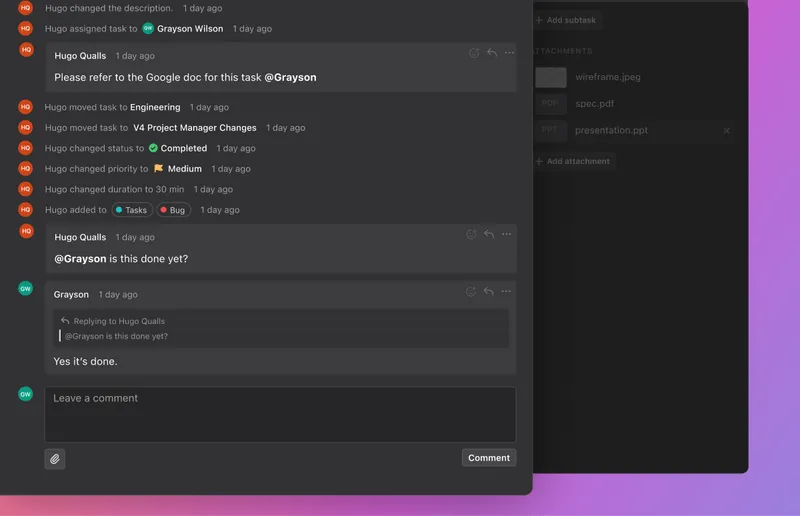
Which is the best calendar for your team?
It’s hard to say. There’s no ‘best calendar’ because the right shareable calendar for your business depends on the features you need and the type of work you’re managing.
For example, if you’re looking for a simple and low-cost option for managing your team’s schedule, Google Calendar will probably be a good calendar migration option. However, a platform like Motion could be a better choice if you want something more intuitive and flexible to help you manage scheduling conflicts, prevent over-booking, and avoid scheduling impossibilities.
With Motion’s intelligent calendar, you can track and organize the entire team’s tasks. Plus, you can view your and the team’s tasks by status, assigned resources, and other filters.
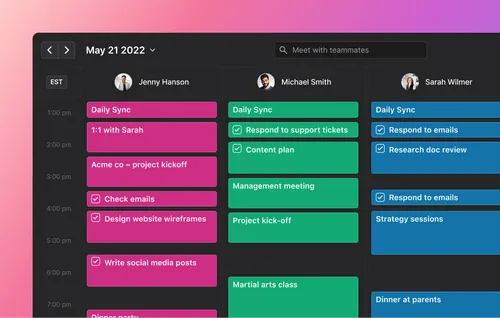
And because our calendar is powered by AI, any changes to the team’s workload automatically reshuffles the schedule. You and your team will instantly see the changes, meaning that everyone knows precisely what their workload involves and when tasks are due.
But there’s more. Motion isn’t only an effective work (and personal) calendar, it's also a very effective AI task manager. Motion will reorganize and reschedule tasks that aren’t completed in the specified timeframe. This means that it can double as an intelligent calendar and help you create the perfect project schedule.
Since it knows everyone’s available work time, it will not overallocate and will alert you if a deadline cannot be met, so you can take appropriate action.
So although there isn't one 'best shared calendar,' there are calendars best suited to your needs. Spend some time figuring out what you want from your shared calendar and find a platform that has all the features and functionalities you’re looking for.
Use Motion to manage your work schedule
A work calendar is a vital tool for the success of your business. It helps you plan, manage, and organize your workload, allowing you and your team to be more productive.
The tricky part is knowing which calendar is the best option for your business. With so many platforms to choose from, it’s hard to know which software to choose. Hopefully, this article has given you some insights into the calendar software that’s out there and the kinds of features you should be looking for.
To learn more about using Motion as your work calendar, sign up for a free trial to understand how it can work for you.




